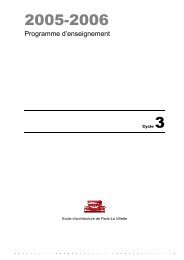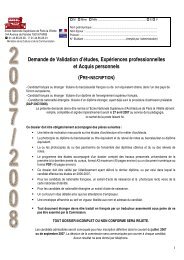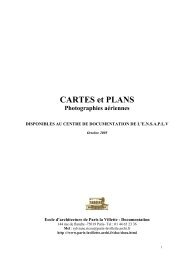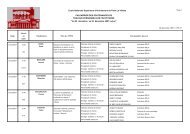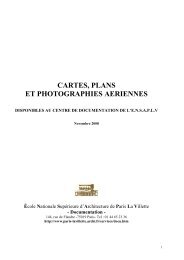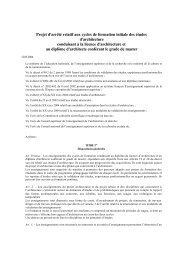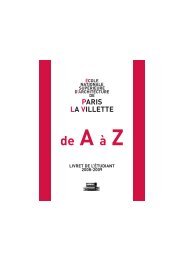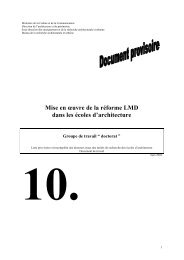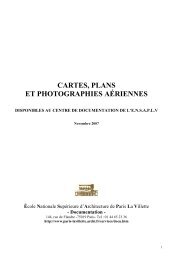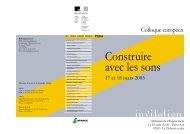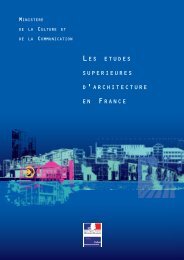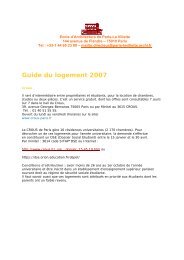Transmitting the past to the future : - Ecole Nationale Supérieure d ...
Transmitting the past to the future : - Ecole Nationale Supérieure d ...
Transmitting the past to the future : - Ecole Nationale Supérieure d ...
Create successful ePaper yourself
Turn your PDF publications into a flip-book with our unique Google optimized e-Paper software.
8<br />
in different and variable proportions, a combination of an Aris<strong>to</strong>telian logic of <strong>the</strong> identity of <strong>the</strong><br />
subject (S) with a Nishidian logic of <strong>the</strong> identity of <strong>the</strong> predicate (P) ; that is, r = S/P; which<br />
reads : reality is a subject taken as a predicate. 25<br />
This conception of reality was anticipated by Zong Bing’s principle, which we could<br />
understand in this light as: <strong>the</strong> reality (r) of a landscape is its intrinsic substance (S : 質 ) taken as<br />
certain representation (P : 霊 ). More specifically, it was anticipated, in Japanese aes<strong>the</strong>tics, by <strong>the</strong><br />
principle of mitate 見 立 て, or “seeing as”; for example, seing mount Hiei ( 比 叡 山 : S), near<br />
Kyô<strong>to</strong>, as if it were mount Lu ( 廬 山 : P), in central China.<br />
But this is not all. Modernity has imposed its technical systems, based mainly on <strong>the</strong><br />
identity of S (since <strong>the</strong>y derive from modern science), in <strong>the</strong> East as well as in <strong>the</strong> West. When<br />
combined with a tradition focussing on P, this can have tremendously disruptive effects, because<br />
<strong>the</strong>re is, so <strong>to</strong> say, no freezing antidote <strong>to</strong> <strong>the</strong> scrapping effects of modernity. Hence, in <strong>the</strong> name of<br />
modernization, <strong>the</strong> massive destructions of <strong>the</strong> built environment which are now going on China,<br />
<strong>the</strong> scale of which exceeds by far any precedent in his<strong>to</strong>ry, and which, for that reason, probably<br />
jeopardize even <strong>the</strong> Chinese capacity of wenhua. It really “kills <strong>the</strong> landscape”, (shafengjing 殺 風 景 ),<br />
<strong>to</strong> borrow an expression devised by Li Shangyin (813-859), a poet of <strong>the</strong> Tang dynasty.<br />
Conclusion<br />
It has nowadays become evident that <strong>the</strong> reigning model of development is unsustainable on<br />
three grounds: 1. Ecologically, because of its disproportionate ecological footprint; 2. Ethically,<br />
because it entails growing inequalities; 3. Aes<strong>the</strong>tically, because it disrupts landscape. In formal<br />
terms, its antidote is preservation; but this only produces more incoherence between what is<br />
preserved and what is not, thus aggravating unsustainability, since a sustainable world cannot be<br />
incoherent. It must rely on a cosmic harmony between our existence and that of <strong>the</strong> things and<br />
o<strong>the</strong>r living beings around us. Landscape is that which expresses this harmony; and correlatively,<br />
“killing <strong>the</strong> landscape” is much more than an aes<strong>the</strong>tical problem: it concerns our very existence<br />
and <strong>the</strong> sustainability of our world. This is <strong>to</strong> say that it is a question of Being. Now, <strong>the</strong><br />
on<strong>to</strong>logical frame of modernity, which is based on <strong>the</strong> <strong>to</strong>pos of individual substances (be <strong>the</strong>y<br />
persons or things), is intrinsically limited <strong>to</strong> <strong>the</strong> individual, both in time and in space. It is, as such,<br />
intrinsically unable <strong>to</strong> ensure a real sustainability, going beyond <strong>the</strong> death, <strong>the</strong> destruction or <strong>the</strong><br />
consumption of <strong>the</strong> individual. In o<strong>the</strong>r words, it can be nothing else than what Heidegger has<br />
termed “Being <strong>to</strong>ward death” (Sein zum Tode).<br />
In such an on<strong>to</strong>logical frame, we can indeed transmit frozen objects from <strong>the</strong> <strong>past</strong> <strong>to</strong> <strong>the</strong><br />
<strong>future</strong>, but we cannot transmit <strong>the</strong> living milieu of a really human existence; because <strong>the</strong> first<br />
expression of <strong>the</strong> modern paradigm, by way of dualism and mechanicism, is <strong>to</strong> negate <strong>the</strong> links<br />
which make a living human milieu.<br />
Consequently, in order <strong>to</strong> ensure <strong>the</strong> sustainability of our world, we have <strong>to</strong> accomplish<br />
an on<strong>to</strong>logical revolution, just like <strong>the</strong> Copernican revolution, which made modernity possible,<br />
was not only cosmological, but on<strong>to</strong>logical as well, since it instituted reality as a set of objective<br />
data (an Umgebung, in Uexküll’s terms) instead of our proper world (Umwelt), thus disrupting <strong>the</strong><br />
relational set of existence. But as, of course, we cannot go back <strong>to</strong> premodern worldviews, what<br />
<strong>to</strong> have <strong>to</strong> do is <strong>to</strong> go beyond modernity. That is, we have <strong>to</strong> become conscious that reality is not a<br />
pure set of objects (pure S), abstracted from our own existence. Since we do exist, we necessarily<br />
“predicate” (through our ways of feeling, thinking, speaking and acting) <strong>the</strong>se abstract objects (S)<br />
in<strong>to</strong> <strong>the</strong> concrete reality of things (S/P).<br />
This amounts <strong>to</strong> saying that reality is relational: it a set of ecological, technical and<br />
symbolic systems, which necessarily exceed <strong>the</strong> on<strong>to</strong>logical <strong>to</strong>pos of <strong>the</strong> individual subject or<br />
object, and integrate both in that same set of relations. By <strong>the</strong> same <strong>to</strong>ken, it exceeds <strong>the</strong> horizon<br />
of individual death: it is not a “Being <strong>to</strong>ward death”, but a “Being <strong>to</strong>ward life” (Sei e no sonzai 生<br />
への 存 在 ), as Watsuji put it, 26 because such sets of relations (i.e. reality) are necessarily social,<br />
and do not cease at <strong>the</strong> moment of <strong>the</strong> individual’s death. In o<strong>the</strong>r words, our Being is not only<br />
individual, but social as well; and for that reason, when we die, each of us can say, like Horatius<br />
put it, non omnis moriar, “I shall not die al<strong>to</strong>ge<strong>the</strong>r”. Indeed, our social “half” will remain alive not<br />
only in our name, our works etc., but in all those collective systems (e.g. language) which,<br />
concretely, were part of our existence and enabled our individual “half” <strong>to</strong> be really human.<br />
25 See above, note 19.<br />
26 Watsuji Tetsurô 和 辻 哲 郎 , Fûdo 風 土 (Human milieux), Tokyo: Iwanami Shoten, 1935, chap. I.



